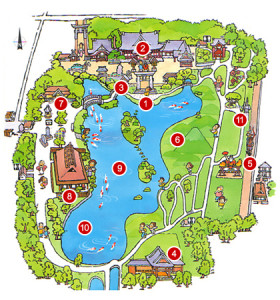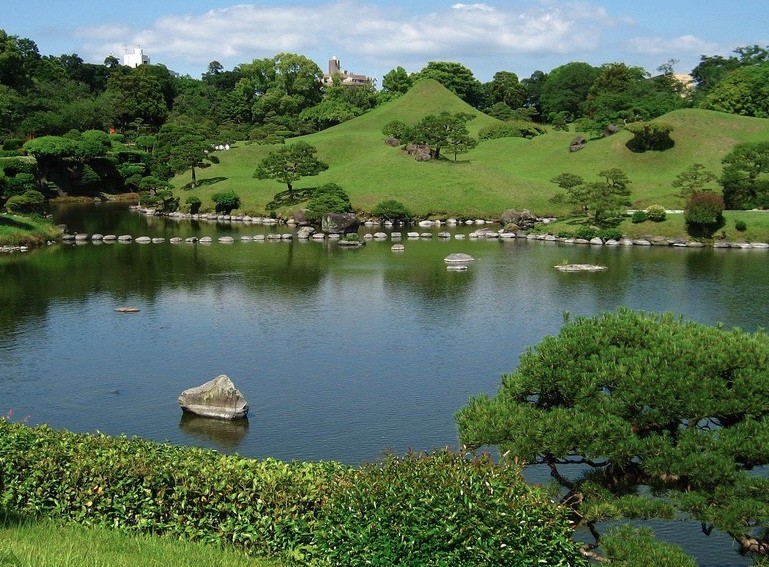Suizenji Gardens
Also known as Suizenji Jojuen Park, these beautiful gardens are situated in the east of the city, a 15 minute tram ride from the city center. Suizenji Jojuen is a very popular destination for both Japanese and international tourists, however, on a weekday it is possible to have the park mostly to yourself sharing it only with the everpresent carp, herons and painstaking gardeners.
Explore Kumamoto can add a trip to Suizenji Jojuen as part of your custom made city tour, just contact us with your request.
Suizenji’s history heralds back to 1637 when it was chosen by the 3rd Hosokawa Lord as a site for a tea house and small temple due to the presence of many underground springs. The crystal clear water bubbles up feeding the large pond and flowing onwards to Ezu lake. The spring water originates in Aso, apparently taking 20 years to travel underground to the Suizenji area. The springs are at a constant temperature of 18C and the water is fabled to bring great longevity to whoever who drinks it.
The gardens which cover 6600 square meters were developed and extended by the 4th and 5th Lords of Kumamoto taking around 80 years to complete. According to different sources the garden was originally designed to portray 12 scenes from the Kumamoto region and it is also said to represent the 53 stations of the Tokaido Road (the original route to Tokyo).
There are two shrines within the grounds, the imposing Izumi Shrine, built at the start of the Meiji era in 1878 and dedicated to the cultural, moral and intellectual leadership of the Hosokawa lineage. Here you will find the drinking spring of long life in an ancient water barrel that was a favourite of the first Hosokawa Lord to rule Kumamoto. The stone was brought back from Korea by Kato Kiyomasa the builder and original Lord of Kumamoto Castle. The shrine was burnt to the ground in WWII and a large white stone monument comemorates its rise from the ashes.
Just past the Izumi shrine you will come to the much smaller Inari shrine, its multitude of red tori gates signify that it is a shrine of agriculture and commerce. The white fox spirits guarding it are the messengers to the gods.
Continue around the park and you will come across two bronze statues dressed in ancient court attire, these are the 1st and 2nd Hosokawa Lords. The 1st Lord was known as Yuusai, he was rumoured to have been an illegitmate son of the Emperor. His mother was from a educated family and Yuusai grew up to be a celebrated scholar and samurai. He was tasked with inducting the Emperor’s younger brother into the classical arts of ancient poetry. The thatched study room which he used in the grounds of the Imperial Palace in Kyoto now stands near the entrance of the park on the shores of the lake. Though only small parts of the original 500 year old structure remain the Kokindenju room has been restored to its original state. The building is now used as a tea room and for 650 Yen you can enter the open sided tatami room and enjoy a bowl of matcha tea and a Japanese sweet while enjoying the scenic lakeside views and garden panorama. In the spring and autumn special tea ceremnoy festivals are held for the public. Contact Explore Kumamoto for details.
Within the grounds of the park there is also an ancient Noh theatre which holds performances in the spring and autumn.
At the back of the park is a Yabusame course. Yabusame is an ancient mounted archery ritual, used to celebrate or pray for a good harvest. Yabusame is held twice yearly at Suizenji Koen on the preceding Sundays to April 22nd and August 18th.
Clustered at the entrance to the park are several small souvenir stalls and an airconditioned room to escape the heat or cold, which contains some interesting historical pictures of the park. In the near future a volunteer guide service will also be stationed in the park offering short guided tours in English.
 Izumi Shrine Tori gate
Izumi Shrine Tori gate- Izumi Shrine
-
The Spring of Longevity
- Noh Theatre
- Yabusame Course
- Mount Fuji View
- Park Entrance
- Tea Rooms
- The Spring Fed Lake
- The Area of Rising Mists
- The Statues of the Lord Yuusai and Tadatoshi Hosokawa
Map accredited to www.suizenji.or.jp
Entrance fee: Adults 400 Yen
Elementary and Junior High School students (age 6 – 15) 200 Yen
Opening Times: March to October 07:30 to 18:00 (last entrance up to 17:30)
November to February 08:30 to 17:00 (last entrance up to 16:30)
[codepeople-post-map]

